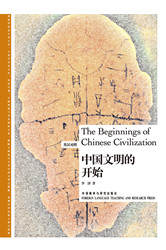��ӭ������52ijӢ��������������С��Ϊ�������Ӣ��֪ʶ�ǣ���������˫��������������ã��й������Ŀ�ʼ������������������ϸ�ķ�����
������˫��������������ã��й������Ŀ�ʼ������

The Beginnings of Chinese Civilization�й������Ŀ�ʼ
����飺��ã������ѧ��ѧ��ʿ������ѧ������ѧ�ң��й�����ѧ֮�����������塢�����ͳ����¿��ŷ�����쵼Ӱ����20�����°�Ҷ�й�����ѧ�ķ�չ��
���ݼ�飺�Ἧ������ڿ���ѧ������ѧ������ߴ����Ե�Ӣ�����ģ����ڻ�ʢ�ٴ�ѧ���ܡ�ʹ�����Ļ��ɴ�˵��Ϊ��ʷ���İ������淢����ݽ��ͷ����й��ִ�����ѧ���γɡ���֤�л�������Դ�����¡�
Important as these inscribed bones are, the associated finds are no less so. Inasmuch as the time can be approximately defined, the material culture, as revealed in the artifacts contemporaneous with this period, can both substantiate the verbal statements on the bones and, to an even greater extent, supplement them. A great deal of our knowledge concerning the culture of this period depends almost entirely on such finds. For instance, it would be difficult to find out from the inscriptions whether the Shang people of this period were still in the stone age or had already begun to use metals; if they used metals, to what extent. The stone or metal objects themselves furnish the exact data. By means of careful stratigraphical study we know for certain now that the Shang people of this period had already mastered to a very advanced degree the secret of casting bronze. They made weapons, ceremonial vessels, and many ornaments of this metal, and developed an extensive bronze industry right on the spot, as proved by the remains of moulds, bronze ore, and slags attached by copper rust. But at the same time, the copper and tin supply must have been somewhat limited, so a great number of utensils were still made both of bronze and stones, such as axes and knives, etc. That it is possible to show and prove that in this period people were using both stone and metals, is, I believe, a great contribution to our knowledge of early Chinese history, and at the same time furnishes new materials for students who are interested in the migrations of early cultures.��Щ�������ֵļǹ�Ȼ��Ҫ����ط��ֵ���Ҫ��Ҳͬ�����ɺ��ӡ����ڿ��Դ���ȷ����һ�Ļ�������ʱ�ڣ�ͬʱ�ڵ�ʷǰ��������ӳ�������Ļ�����������֤ʵ���ϵ��������ݣ����һ��ܸ���һ���ز�����Щ�������ݡ����ǹ�����һʱ���Ļ���������ʶ������ȫ��������Щ���֡����磬�Ӽ����У����ǻ�����ȷ������һʱ�ڵ��������Դ���ʯ��ʱ���������Ѿ���ʼʹ�ý������������ʹ�ý�������ʲô�̶ȡ�ʯ�������ʵ�ﱾ���ṩ���ⷽ���ȷ�����ϡ�������ϸ�ĵز��о�����������ȷ֪����һʱ�ڵ������Ѿ��������൱�Ƚ�����ͭ��������������ͭ�������������������Ʒ���ڵ��ط�չ�����Ӵ����ͭҵ���˵���ɵ��س�������ģ��ͭ���Լ�����ͭ�������֤���������ͬʱ��ͭ�����Ĺ�Ӧ�ض����ޣ���˻��д����������縫ͷ�͵��ӵȣ���������ͭ��ʯͷ�������ġ�������Ϊ������һʱ�����ǿ��ܼ�ʹ��ʯ����ʹ�ý�����һ��ʵ�ı��ֺ���֤��������������Ƕ����й�������ʷ����ʶ��ͬʱҲΪ�������Ļ�Ǩ������Ȥ��ѧ���ṩ���µIJ��ϡ�
Ceramics, which are basic archaeological materials, have been found in great quantity. They consist of many fundamentally different types, easily proven to be an aggregation of different local productions, as is to be expected of a metropolitan culture. One of the amazing discoveries concerning this industry is its use of glaze, the beginning of which has been hitherto considered to be sometime in the Han Dynasty. In spite of its aggregative character, the ceramics on the whole share certain individual traits typical of this period. For instance they are all monochrome and decorated by incised lines, entirely different from the aëneolithic Yang-shao ceramics, which are polychrome and decorated by paintings. Survivals of Yang-shao wares were discovered on this site. This discovery is of some importance because it helps to determine the lower limit of the age of Yang-shao which has never been definitely fixed.������������ѧ�Ļ�������֮һ�����ѱ��������֡������ֵ���������������������ͣ���Ȼ֤�������Dz�ͬ���������Ļ�ۣ�����������Ԥ���еĴ����Ļ�һ����������һ��ҵ��һ��˷������Ե�ʹ�á���ǰѧ��һֱ��Ϊ���Ե�ʹ���������ں�����������Щ�����Ǵ�����˷���۶������������϶�����һʱ�������ļ����������������磬���Ƕ��ǵ�ɫ�ģ�����װ����������ȫ��ͬ��������ʯ��ʱ�����ֶ�ɫ�����ε�����������ʱ��������Ŵ�Ҳ��������һ��ַ����һ���ֵ��������ڣ���������ȷ����ǰһֱδ��ȷ��������ʱ�ڵ�ʱ�����ޡ�
The finds also contain many decorative works of shell, stone, and bone, illustrating profusely the art of the period. The decorative elements on the whole are quite consonant with the traditional ideas relating to the art of the period, only proving to be more luxurious. When they are worked out, it will be possible to determine the relationship with the various surrounding centers that were contemporaneous with this culture.�������л���������װ���Եı��ǡ�ʯ���ǵȣ����չʾ����һʱ�ڵ���������Щװ����Ԫ�ش������Ͽ����й���һʱ�������Ĵ�ͳ���������ֻ�Ǹ��ӷḻ��ʡ�����ЩԪ�ص���ȷ�������п���ȷ��������ͬʱ���ܱ��Ļ�����֮��Ĺ�ϵ��
These are only a few examples of the finds from this site; many are still in the hands of specialists whose opinions are being awaited as to their real significance. Even these few are sufficient to show the general nature of the contents and the importance that may be attached to them. From an archaeological viewpoint it is most fortunate that this site should have been chosen for the first serious work. When the materials are thoroughly studied they will help to clarify many difficult problems and serve as standard of definite value by which others may be compared and judged. In other words we have got a key site in North China, gradually worked out and found a guide to direct our search in the archaeological maze of the Yellow River Valley.����ֻ���й���һ��ַ������ļ������ӣ���������ӻ���ר���ǵ��������������Ҫ�Ի��д�ר�ҵ���������������⼸�������Ա�����Щ���ֵ�һ�����ʼ�����ܾ߱�����Ҫ�ԡ��ӿ���ѧ�ĽǶ�������ѡ����һ��ַ��Ϊ��һ����ʽ�������ʮ�����˵ġ����Ͼ��������о��������ڳ����������⣬���䵱���Լ�ֵ�������ʲ��ա��жϡ�����֮�������Ѿ��ڻ�������������һ����Ϊ�ؼ�����ַ�����������ó���һ��ָ�������ڻƺ������չ�̽����ָ�ϡ�
Future Prospectδ��չ��
The work of the Institute has already created a widespread interest in archaeological excavation in China. To follow up this work many plans have been made by various universities and museums to excavate early remains. It can be safely predicted therefore that as soon as the country is politically settled there will be a flourishing period of archaeological diggings. But from practical experience can we say anything about the archaeological prospects of this country?ʷ�����Ĺ��������й�������һ��㷺�Ŀ��ŷ�����ȳ�����������һ����֮�������ѧ�Ͳ�����ƶ��ƻ���������������ַ����ˣ����Դ�Ԥ�⣬һ�����������ϰ������������ϻ���һ����æ�Ŀ��ŷ����ڵ�������������ʵ��������ԣ����Ƕ��ڱ����Ŀ���ǰ������˵Щʲô�� ?
I have been told that when Sir Flinders Petrie first went to Egypt in 1880 he was not at all encouraged by any of his senior workers; the fact was that Egypt seemed to many experts at that time to have been archaeologically exhausted. Fifty years have now passed since his first triangulation of the Pyramids in Gizeh, and many undreamed of discoveries have been made, one after another in this period; yet, to this day, Egyptology seems to be a field for young archaeologists just as alluring as it was fifty years ago. China possesses an ancient tradition and is just beginning to be explored. Results of the recent works prove most substantially that the spade can work just as many wonders here as it did in other old countries. The forgotten history of China will certainly be written on materials to be recovered from this source, as has been the case with Mesopotamia, Egypt, Greece, and Rome.�����������߱���˵��1880 ��������ǰ������ʱ��û��һ��ǰ��������������ʱ������ר�ҿ������ӿ���ѧ�����Ͻ����������ѿ�֮���������ٿ��������Լ����Ľ������������Ƕ�λ�������Ѿ���ʮ���ȥ�ˡ������ʱ�������ǰ�������ζ�δ�뵽���ķ���ȴһ����һ�������ˡ�ֱ������Ϊֹ����������Ŀ���ѧ����˵������ѧ����������ǰ���������������й����Ź��ϵĴ�ͳ��̽���Ÿոտ�ʼ������Ĺ���������֤����һ�������������Ź����Է����漣�����й�ͬ�����Է����漣��ͬ�����������ǡ�������ϣ��������һ����������һԴͷ������������ϣ��й�����������ʷ�ؽ���������д��
 �༭�Ƽ���
�༭�Ƽ���
�ִ�����ѧ�������þ���ԭ���״ι��ڷ���
ǰ��ƪӢ��ԭ��������ʮ��������ٰ�
��ƪ��Ӣ����ѧ�����������й�����Դ��Ӣ��ԭ��
���й������Ŀ�ʼ����Ӣ�����հ棩
��ã���������ӡ���ұ����������ȣ��룩
�����ѧ���о�������
- �����б����������۽������ѱ�����˿���������������վͬ����۵��֤ʵ��������
-
